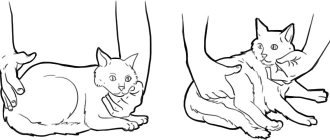One of the most important organs of any living organism is the heart, which provides blood flow and responds very subtly to any changes in well-being. Based on the characteristic signs, the owner can independently determine the current state of the heart at home and, knowing what the dog’s pulse should be, take the necessary measures to restore the pet’s health. From the article you will learn how a dog's pulse is measured, what indicators are considered normal for a certain weight, size and age, and what deviations you should pay close attention to.
Standard heart rate indicators for dogs
The rhythm of the pulse is determined by the vibrations of the walls of large arteries that appear during contraction of the heart muscle. Using this indicator, you can assess the health status of your four-legged pet. Failures can be the result of heart disease, serious poisoning, disturbances in the functioning of internal organs, or hypothermia. It is periodically necessary to check the pulse for preventive purposes in order to identify possible problems in time.
The normal pulse rate in dogs varies over a wide range. The norm may be a rhythm of 70 to 180 beats per minute. This variation is explained by the dependence of the indicators on the size and age of the pet. For small dogs, such as a Chihuahua or a pug, the norm may be a pulse of 150 to 180 beats, for medium-sized pets it is 120-140, and for representatives of large breeds, for example, a St. Bernard, a pulse of about 100 is considered normal.
This indicator is also influenced by age. In an older dog, all processes naturally slow down, including the speed of blood flow. Their heart rate will not be as high as that of a puppy or young animal. There may also be individual deviations. In order to determine the norm for a particular dog, you need to measure the pulse of a healthy dog in a calm state for several days and calculate the average result.
Briefly about the main thing
- Pulse is an important indicator of proper heart function;
- The “norm” of its indicators is not the same for all animals and depends on age, weight, size and physical condition;
- There are pathological and physiological changes;
- The owner should take periodic measurements and keep a log;
- Pathological changes indicate congenital diseases of the heart muscle or the presence of a disease;
- Treatment of the animal is carried out under the supervision of a veterinarian, after appropriate research and analysis.
Do you take periodic measurements of your pet? Can you do this? What abnormalities were identified and how was the treatment? Share your experience in the comments to the article, it will help our other readers.
Did you like the article? Share it with your friends on social media. networks. This will help them get useful information and support our project.
Causes of increased heart rate
An increased heart rate is not always a consequence of the presence of a disease. Tachycardia will be observed after active games and jogging. The rhythm accelerates if the dog is frightened by something or is in a state of stress. If there are no natural causes for tachycardia, and an increase in heart rate is observed regularly, this may be a consequence of:
- diseases of the cardiovascular system;
- malignant tumors in the respiratory system;
- inflammatory processes;
- disruptions in the functioning of the endocrine system.
Increased heart rate is observed in coronary artery disease, arterial hypertension, and myocardial infarction. This disorder can appear during endometritis, pneumonia, and inflammation in the heart tissues. It is one of the symptoms of diabetes and hyperthyroidism. With regular tachycardia, it is necessary to have the dog examined at a veterinary hospital.
Laryngeal paralysis
This condition is common in older dogs of large breeds (such as Labradors, golden retrievers). The essence of the disease is that the lumen of the larynx, which is located behind the pharynx and in front of the trachea, loses its ability to expand during inhalation. The larynx stops opening and the flow of air cannot penetrate the windpipe.
An early sign of the disease is a change in the timbre of barking; in some cases, the dog completely loses the ability to bark. Breathing becomes difficult and very noisy.
Laryngeal paralysis is often found in animals that experience difficulty breathing after vigorous or moderate exercise. Sometimes paralysis manifests itself more clearly when the weather changes (warming), which makes it possible to establish a diagnosis. Severe respiratory distress in overweight dogs in hot, humid weather is also typical of this disease.
It is important to exclude symptoms of rabies when such complaints occur!!! This disease is deadly for people and animals.
It is important to consider: • was the animal vaccinated against rabies no more than 12 months ago? • Has your dog been bitten by other animals for at least 2 months? • Is the animal kept in areas where rabies has occurred?
At the slightest suspicion of rabies, you must contact your local state veterinary clinic! First aid for difficulty breathing due to paralysis: • wet the dog's chest and stomach with cool or cold water; • minimize exposure to stress factors; • do not try to insert your hands or any instruments into the dog's mouth, unless you see a foreign object in the dog's throat when he breathes with an open mouth; • Take the dog to the clinic immediately.
Signs of tachycardia
It is not always possible to regularly check your dog's heart rate. There are certain signs indicating the presence of malfunctions in the functioning of the organ. In a pet with a rapid heart rate:
- there is general weakness, reluctance to move actively;
- mucous membranes turn pale;
- appetite decreases;
- shortness of breath appears during exertion;
- a noise is heard when breathing, the mouth is open;
- cough appears;
- The temperature periodically rises to 39°C.
The dog examination program to identify the causes of tachycardia includes: blood and urine tests, electrocardiogram, ultrasound of the abdominal cavity, sternum, and radiography.
Transportation of the victim
The best thing you can do for a sick and, in particular, injured animal is to take it to a veterinary clinic. Give the victim maximum peace and comfort. Transport stray dogs with extreme caution. Such animals, as a rule, are not accustomed to people; when you approach, all of them, and especially the injured ones, will experience severe fear. You can use plywood or other hard material as a stretcher. Secure your dog to the stretcher using rope or duct tape. Small dogs can be transported in boxes lined with fabric.
Causes of bradycardia
A slow heart rate is medically called bradycardia. Heart rate decreases when:
- severe poisoning with lead, nicotine, pesticides, and other toxic substances;
- ischemia, cardiac atherosclerosis, myocarditis, arterial hypotension;
- prolonged fasting;
- hypothermia;
- viral hepatitis, other infections;
- internal bleeding caused by cirrhosis of the liver, malignant tumors, ulcers in the digestive organs resulting from injuries;
- increased intracranial pressure due to meningitis, stroke, traumatic brain injury, bruise.
The rhythm may slow down if the dose of cardiac medications is not taken.
Symptoms that appear with a decreased rhythm should cause concern for the animal owner. It is necessary to urgently contact a veterinarian if convulsions are periodically observed, the dog gets tired quickly, even without exercise, and its paws become tangled while walking. After a full examination, ECG and ultrasound of the heart, the doctor will determine the cause of the disturbances in heart rhythm and prescribe effective treatment.
How to measure a dog's blood pressure?
Today, there are several ways to determine blood pressure levels in dogs. Let's look at them in the table below.
Blood pressure in dogs is measured using invasive and non-invasive methods.
Table 3. Methods for determining blood pressure in dogs
| Way | Description |
| Invasive | It involves measuring pressure directly from inside the dog’s body. In fact, specialized medical measuring instruments are partially found in the tissue of his body. So, an arterial-type catheter specially designed for this purpose is inserted into a large blood vessel, which, in turn, is connected to the device itself that performs the measurements. This technique is considered the most accurate and acceptable for determining pressure, but its use is practiced only when the dog is under the influence of anesthesia, in other words, when the animal is undergoing surgery. Upon request, this procedure is not carried out, since there is an obvious discrepancy between the benefits of measuring pressure and the damage caused by anesthesia. This procedure is prohibited without anesthesia, as the dog will experience very severe pain. |
| Non-invasive | The category of such measurement methods includes:
|
A veterinary electric tonometer is very convenient for determining blood pressure in dogs.
Assuming your dog is not on the operating table, you will need to visit your veterinarian to have your dog's blood pressure measured with a blood pressure monitor. This device can be:
- mechanical, in which air will be pumped into the sleeve by pressing a bulb - a rubber pump;
- electronic, in which air will enter the cuff through the automatic operation of the compressor.
Whatever device you choose, it will be placed on the dog’s tail or paw to measure the dog’s blood pressure. The pressure level will be reflected on a special dial. It is necessary to track at what numerical value the blood pulsation under the cuff will begin and when the pulsation will stop. Both of these marks will be components of the animal's blood pressure indicator.
In order for the animal to stop being afraid of the tonometer, it is best to measure pressure at least 3 times in a row.
Please note: it is recommended to take approximately 3 to 5 pressure measurements on dogs in one approach with short breaks. This is necessary so that the animal stops worrying about the procedure, evaluates the zero degree of pain and calms down. The fact is that in a state of excitement, the pulse of any living creature increases, creating a certain error in measurement. To avoid this, repeat the procedure several times in a row.
Is it possible to measure a dog's blood pressure with a human blood pressure monitor?
Some dog lovers, in order not to purchase a specialized blood pressure monitor for dogs, make do with a device designed for humans when measuring blood pressure. A little trick: for this they take a device with a cuff for children.
It is much easier to measure a dog’s blood pressure with a human tonometer with a children’s cuff.
Despite the fact that, judging by the reviews, the results of such measurements are quite consistent with the truth, it is not necessary all the time, so it is best to double-check the indicators collected independently in a veterinary clinic.
Measuring a dog's blood pressure using a tonometer
Video - Measuring a dog's blood pressure at home
Determining a dog's pulse
The procedure for measuring the pulse will not create problems if the house has a special veterinary automatic device that detects pressure and heart rate. But not all owners of four-legged pets have such blood pressure monitors. In this case, you can measure your pulse using a watch with a second hand.
In humans, this indicator is most easily determined by pressing on a blood vessel in the wrist area. There is a good place to measure the pulse of dogs. A large artery runs through the inner thigh, which will help to accurately determine the indicator. To do this you need:
- lay the dog on its back or side;
- place your finger on the artery, press lightly until you feel shock;
- note the time, count the number of shocks.
If the dog behaves calmly during the procedure, the number of blows over the course of a minute is counted. This allows you to get a more accurate result. But such a procedure will not be possible with a restless pet. Consequently, its time will have to be reduced. You need to count the number of blows within 15 seconds, multiply the result by 4, you will get the desired result. You should not measure your pulse after walking or active games. It will definitely be overestimated, which means it will not be possible to find out about the presence of violations.
Reasons for changes in heart rate
The frequency may decrease in a healthy animal during sleep. But while awake, this indicates health problems and occurs during:
- heart disease;
- hypothermia;
- exhaustion;
- poisoning;
- infections;
- diseases of the endocrine system.
If the normal heart rate changes for unknown reasons, the pet should be taken to the veterinarian. Until this point, if the frequency of blows is reduced, the animal must be warmed up by wrapping it in a blanket or blanket.
If the frequency of beats is normal, but their rhythm is abnormal, the dog should be shown to a veterinary cardiologist. Such failures may indicate a disturbance in the conduction of the heart muscle, as well as arrhythmia.
During loss of consciousness, the dog's pulse weakens so much that it cannot be felt. In this case, urgent assistance is required, and all his instructions must be followed until the veterinarian arrives.
Beats per minute
This is the number of heart beats in a certain period of time - per minute. But you can measure your pulse for half a minute or 15 seconds, and then multiply it to normal. For example, if you measured your pulse for 15 seconds, then multiply the resulting amount by 4; if 30 seconds, then multiply by 2.
The normal heart rate of dogs varies depending on the size and age of the animal. In puppies the number of beats will be greater than in adults; in large breeds the pulse is slower. But it’s worth considering another factor - what state the dog is in: after a run or just after sleep.
Finding out whether a rapid heartbeat is a sign of illness is easy. If after physical activity the pulse quickly returns to normal, then the dog is healthy. If the pet is sick, then it will have a rapid heartbeat for a long time.










